Lexus LC Cabriolet (2021 year). Manual in english — page 13
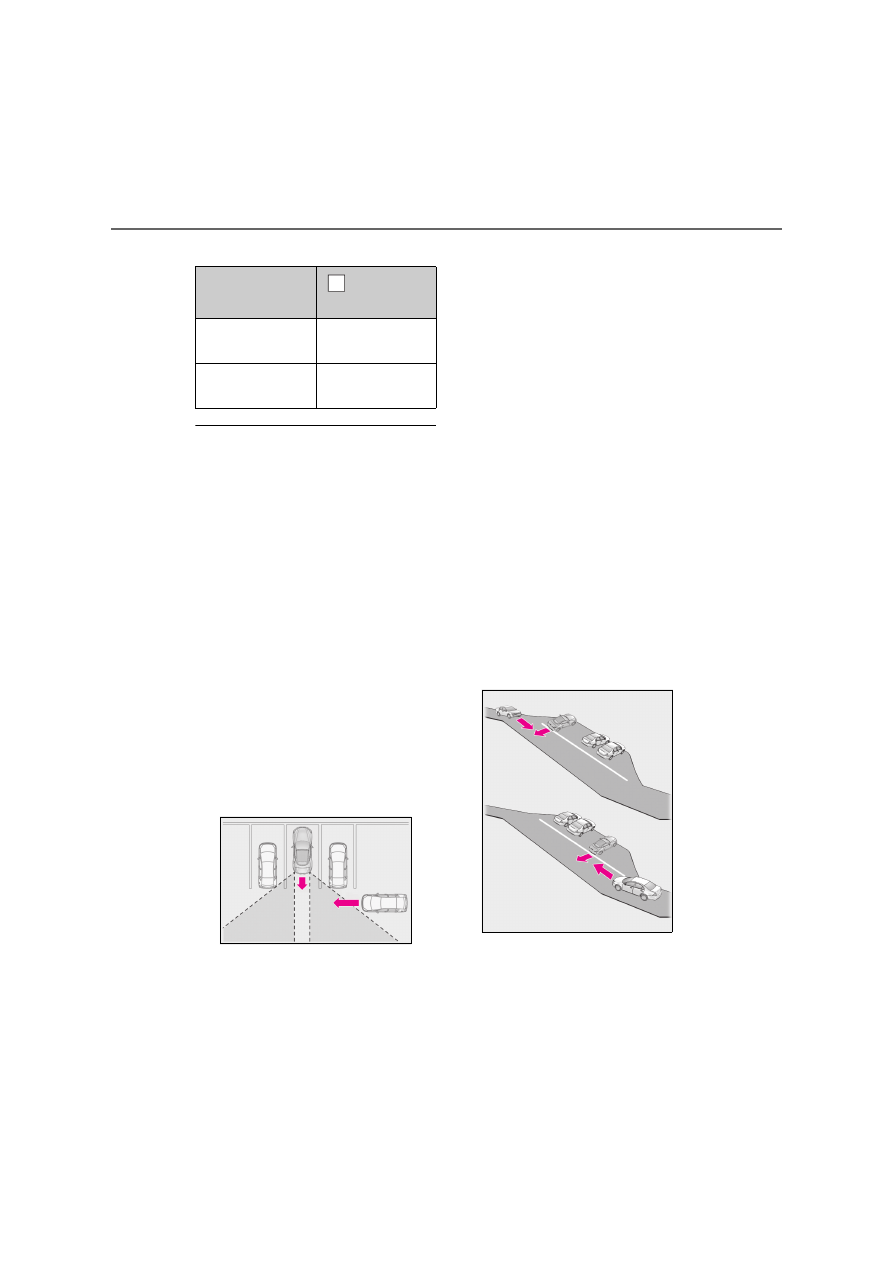
288
4-5. Using the driving support systems
Example:
Q
The RCTA function is operational when
The RCTA function operates when all of the
following conditions are met:
O
The RCTA function is on.
O
The shift position is in R.
O
The vehicle speed is less than approxi-
mately 8 km/h (5 mph).
O
The approaching vehicle speed is
between approximately 8 km/h (5 mph)
and 28 km/h (18 mph).
Q
Conditions under which the RCTA
function will not detect a vehicle
The RCTA function is not designed to
detect the following types of vehicles
and/or objects:
O
Vehicles approaching from directly
behind
O
Vehicles backing up in a parking space
next to your vehicle
O
Vehicles that the sensors cannot detect
due to obstructions
O
Guardrails, walls, signs, parked vehicles
and similar stationary objects
*
O
Small motorcycles, bicycles, pedestrians,
etc.
*
O
Vehicles moving away from your vehicle
O
Vehicles approaching from the parking
spaces next to your vehicle
*
*
: Depending on the conditions, detection
of a vehicle and/or object may occur.
Q
Conditions under which the RCTA
function may not function correctly
O
The RCTA function may not detect vehi-
cles correctly in the following situations:
• When the sensor is misaligned due to a
strong impact to the sensor or its sur-
rounding area
• When mud, snow, ice, a sticker, etc. is
covering the sensor or surrounding area
on the rear bumper
• When driving on a road surface that is
wet with standing water during bad
weather, such as heavy rain, snow, or fog
• When multiple vehicles are approaching
with only a small gap between each vehi-
cle
• When a vehicle is approaching at high
speed
• When a towing eyelet is installed to the
rear of the vehicle.
• When backing up on a slope with a sharp
change in grade
• When backing out of a shallow angle
parking spot
Approaching vehi-
cle speed
Approximate
alert distance
28 km/h (18 mph)
(fast)
20 m (65 ft.)
8 km/h (5 mph)
(slow)
5.5 m (18 ft.)
A
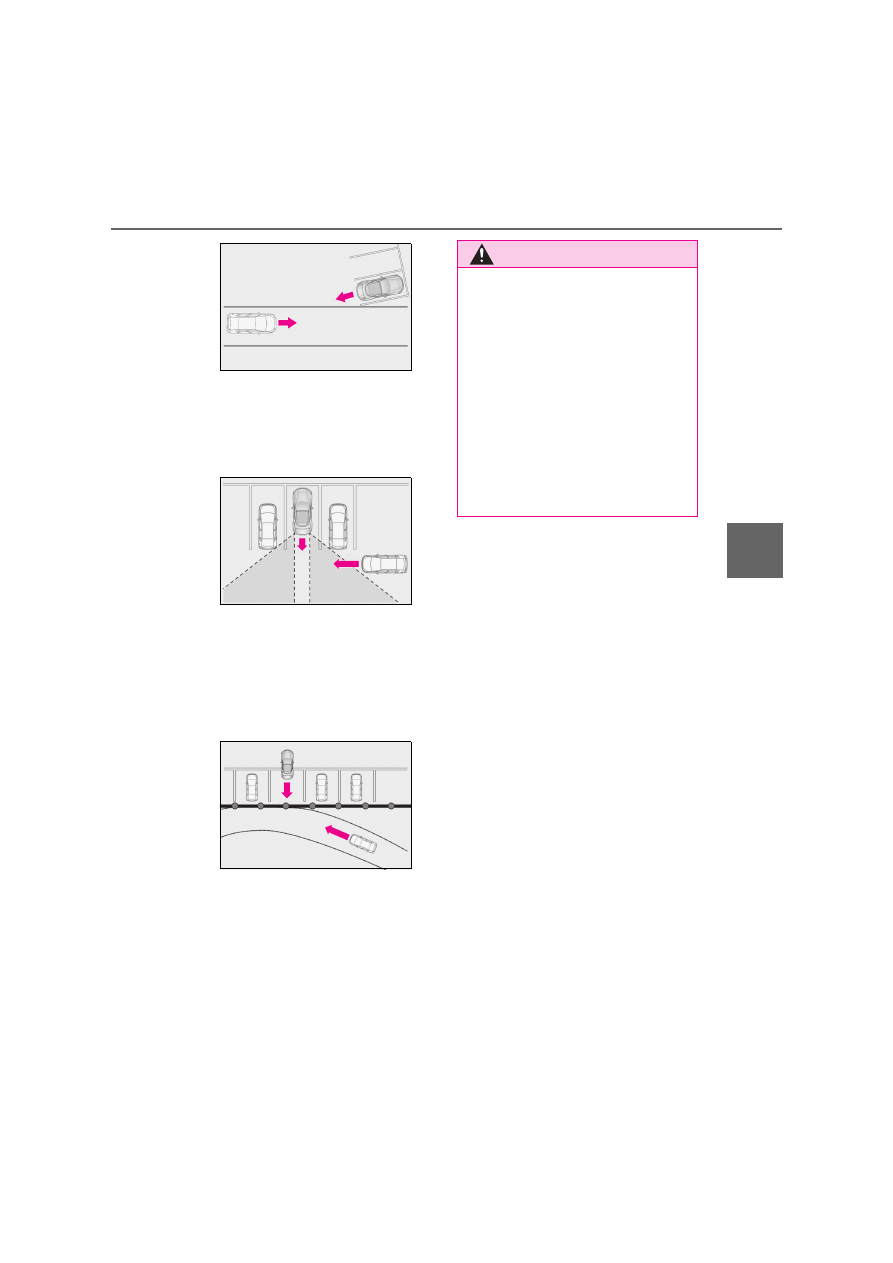
289
4
4-5. Using the driving support systems
Dr
ivin
g
• Immediately after the RCTA function is
turned on
• Immediately after the engine is started
with the RCTA function on
• When the sensors cannot detect a vehi-
cle due to obstructions
O
Instances of the RCTA function unneces-
sarily detecting a vehicle and/or object
may increase in the following situations:
• When a vehicle passes by the side of your
vehicle
• When the parking space faces a street
and vehicles are being driven on the
street
• When the distance between your vehicle
and metal objects, such as a guardrail,
wall, sign, or parked vehicle, which may
reflect electrical waves toward the rear of
the vehicle, is short
• When a towing eyelet is installed to the
rear of the vehicle.
WARNING
Q
Cautions regarding the use of the
function
The driver is solely responsible for safe
driving. Always drive safely, taking care
to observe your surroundings.
The RCTA function is only a supplemen-
tary function which alerts the driver that a
vehicle is approaching from the right or
left at the rear of the vehicle. As the
RCTA function may not function cor-
rectly under certain conditions, the
driver’s own visual confirmation of safety
is necessary. Over reliance on this func-
tion may lead to an accident resulting
death or serious injury.
290
4-5. Using the driving support systems
*
: If equipped
Q
ECB (Electronically Controlled
Brake System)
The electronically controlled system
generates braking force correspond-
ing to the brake operation
Q
ABS (Anti-lock Brake System)
Helps to prevent wheel lock when the
brakes are applied suddenly, or if the
brakes are applied while driving on a
slippery road surface
Q
Brake assist
Generates an increased level of brak-
ing force after the brake pedal is
depressed when the system detects a
panic stop situation
Q
VSC (Vehicle Stability Control)
Helps the driver to control skidding
when swerving suddenly or turning on
slippery road surfaces
Q
TRC (Traction Control)
Helps to maintain drive power and
prevent the drive wheels from spinning
Exhaust Gas Filter system
*
The Exhaust Gas Filter system is
designed to collect particulate mat-
ter in the exhaust gases using an
exhaust gas filter installed to the
exhaust pipes.
NOTICE
Q
To prevent the Exhaust Gas Filter
system from failing
O
Do not use fuel other that the specified
type
O
Do not modify the exhaust pipes
Driving assist systems
To keep driving safety and perfor-
mance, the following systems oper-
ate automatically in response to
various driving situations. Be
aware, however, that these systems
are supplementary and should not
be relied upon too heavily when
operating the vehicle.
Summary of the driving assist
systems

291
4
4-5. Using the driving support systems
Dr
ivin
g
when starting the vehicle or accelerat-
ing on slippery roads
Q
Active Cornering Assist (ACA) (if
equipped)
Helps to prevent the vehicle from drift-
ing to the outer side by performing
inner wheel brake control when
attempting to accelerate while turning
Q
Hill-start assist control
Helps to reduce the backward move-
ment of the vehicle when starting on an
uphill
Q
EPS (Electric Power Steering)
Employs an electric motor to reduce
the amount of effort needed to turn the
steering wheel
Q
AVS (Adaptive Variable Suspen-
sion System)
By independently controlling the
damping force of the shock absorbers
for each of the 4 wheels according to
the road and driving conditions, this
system helps riding comfort with supe-
rior vehicle stability, and helps good
vehicle posture
Also, the damping force changes
depending on the selected driving
mode. (
P.262)
Q
VDIM (Vehicle Dynamics Inte-
grated Management)
Provides integrated control of the
ABS, brake assist, TRC, VSC, hill-start
assist control and EPS systems
Helps to maintain vehicle stability
when swerving on slippery road sur-
faces by controlling the brakes, engine
output, steering assist (if equipped),
and steering ratio (if equipped)
Q
Emergency brake signal
When the brakes are applied suddenly,
the stop lights automatically flash to
alert the vehicle behind
Q
Secondary Collision Brake
When the SRS airbag sensor detects a
collision and the system operates, the
brakes and brake lights are automati-
cally controlled to reduce the vehicle
speed and help reduce the possibility
of further damage due to a secondary
collision.
Q
When the TRC/VSC/ABS systems are
operating
The slip indicator light will flash while the
TRC/VSC/ABS systems are operating.
Q
Disabling the TRC system
If the vehicle gets stuck in mud, dirt or snow,
the TRC system may reduce power from
the engine to the wheels. Pressing the
switch to turn the system off may
make it easier for you to rock the vehicle in
order to free it.
To turn the TRC system off, quickly press
and release the
switch.
The “Traction Control Turned Off” will be
shown on the multi-information display.
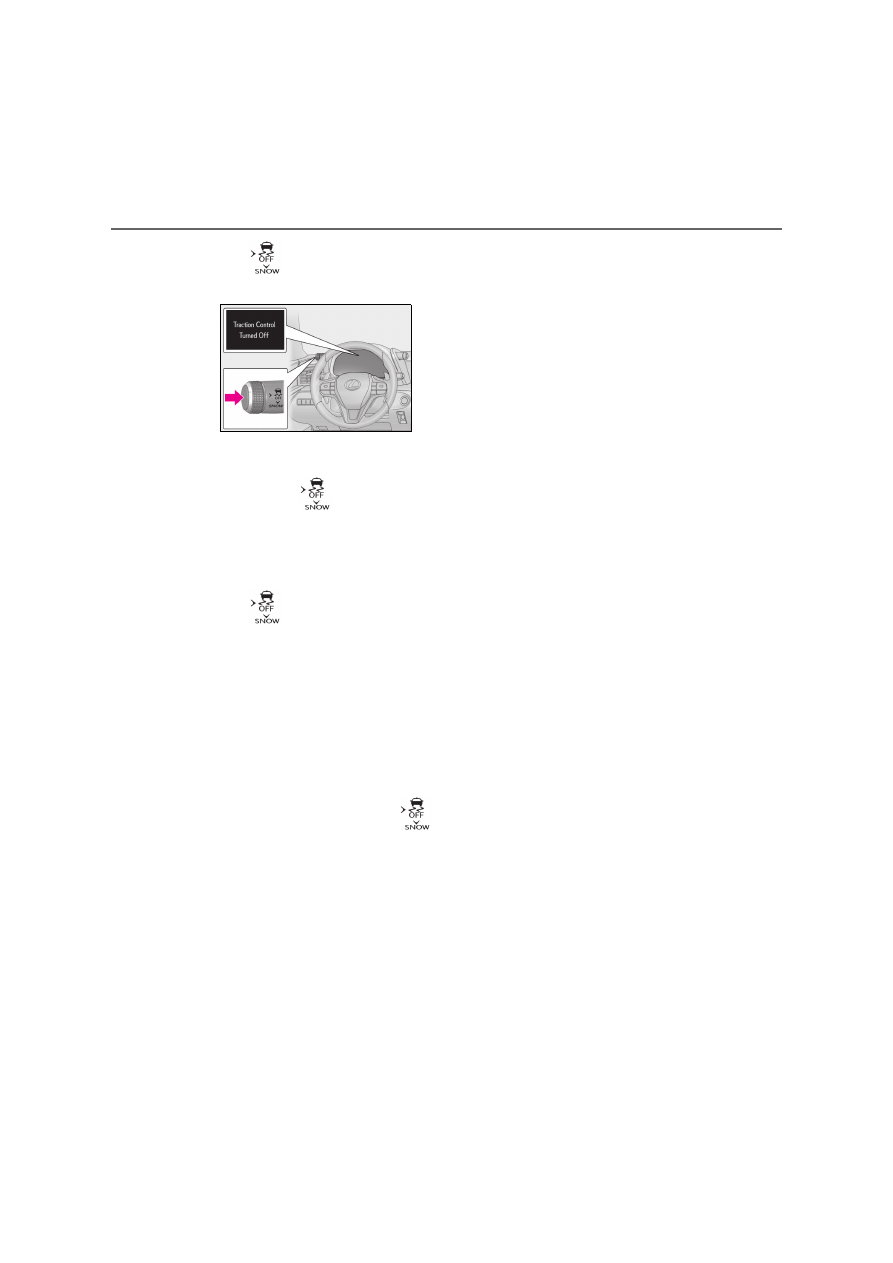
292
4-5. Using the driving support systems
Press the
switch again to turn the
system back on.
Q
Turning off both TRC and VSC systems
To turn the TRC and VSC systems off,
press and hold the
switch for more
than 3 seconds while the vehicle is stopped.
The VSC OFF indicator light will come on
and the “Traction Control Turned Off” will
be shown on the multi-information display.
*
Press the
switch again to turn the
systems back on.
*
: PCS (Pre-Collision System) will also be
disabled (only Pre-Collision warning is
available). The PCS warning light will
come on and a message will be displayed
on the multi-information display.
(
P.239)
Q
When the message is displayed on the
multi-information display showing that
TRC has been disabled even if the
switch has not been pressed
TRC is temporary deactivated. If the infor-
mation continues to show, contact any
authorized Lexus retailer or Lexus autho-
rized repairer, or any reliable repairer.
Q
Operating conditions of hill-start assist
control
When the following four conditions are met,
the hill-start assist control will operate:
O
The shift position is in a position other
than P or N (when starting off for-
ward/backward on an upward incline).
O
The vehicle is stopped.
O
The accelerator pedal is not depressed.
O
The parking brake is not engaged.
Q
Automatic system cancelation of hill-
start assist control
The hill-start assist control will turn off in any
of the following situations:
O
The shift position is shifted to P or N.
O
The accelerator pedal is depressed.
O
The parking brake is engaged.
O
2 seconds at maximum elapsed after the
brake pedal is released
Q
Sounds and vibrations caused by the
ABS, brake assist, VSC, TRC and hill-
start assist control systems
O
A sound may be heard from the engine
compartment when the brake pedal is
depressed repeatedly, when the engine is
started or just after the vehicle begins to
move. This sound does not indicate that a
malfunction has occurred in any of these
systems.
O
Any of the following conditions may
occur when the above systems are oper-
ating. None of these indicates that a mal-
function has occurred.
• Vibrations may be felt through the vehi-
cle body and steering.
• A motor sound may be heard also after
the vehicle comes to a stop.
Q
Active Cornering Assist operation
sounds and vibrations
When the Active Cornering Assist is oper-
ated, operation sounds and vibrations may
be generated from the brake system, but
this is not a malfunction.
Q
ECB operating sound
ECB operating sound may be heard in the
following cases, but it does not indicate that
a malfunction has occurred.
O
Operating sound heard from the engine
compartment when the brake pedal is
operated.
O
Motor sound of the brake system heard
293
4
4-5. Using the driving support systems
Dr
ivin
g
from the front part of the vehicle when
the driver’s door is opened.
O
Operating sound heard from the engine
compartment when one or two minutes
passed after the stop of the engine.
Q
EPS operation sound
When the steering wheel is operated, a
motor sound (whirring sound) may be
heard. This does not indicate a malfunction.
Q
Automatic reactivation of TRC and
VSC systems
After turning the TRC and VSC systems off,
the systems will be automatically re-
enabled in the following situations:
O
When the engine switch is turned off
O
If only the TRC system is turned off, the
TRC will turn on when vehicle speed
increases
If both the TRC and VSC systems are
turned off, automatic re-enabling will not
occur when vehicle speed increases.
Q
Operating conditions of Active Corner-
ing Assist
The system operates when the following
occurs.
O
TRC/VSC can operate
O
The driver is attempting to accelerate
while turning
O
The system detects that the vehicle is
drifting to the outer side
O
The brake pedal is released
Q
Operating conditions of emergency
brake signal
When the following conditions are met, the
emergency brake signal will operates:
O
The emergency flashers are off.
O
Actual vehicle speed is over 55 km/h
(35 mph).
O
The system judges from the vehicle
deceleration that it is a sudden braking
operation
Q
Automatic system cancelation of emer-
gency brake signal
The emergency brake signal will be can-
celed in any of the following situations:
O
The emergency flashers are turned on.
O
The system judges from the vehicle
deceleration that is not a sudden braking
operation.
Q
Secondary Collision Brake operating
conditions
The system operates when the SRS airbag
sensor detects a collision while the vehicle
is in motion.
However, the system does not operate in
any of the following situations.
O
The vehicle speed is below 10 km/h (6
mph)
O
Components are damaged
Q
Secondary Collision Brake automatic
cancellation
The system is automatically canceled in any
of the following situations:
O
The vehicle speed drops below approxi-
mately 10 km/h (6 mph)
O
A certain amount of time elapses during
operation
O
The accelerator pedal is depressed a
large amount
Q
Reduced effectiveness of the EPS sys-
tem
The effectiveness of the EPS system is
reduced to prevent the system from over-
heating when there is frequent steering
input over an extended period of time. The
steering wheel may feel heavy as a result.
Should this occur, refrain from excessive
steering input or stop the vehicle and turn
the engine off. The EPS system should
return to normal within 10 minutes.
WARNING
Q
The ABS does not operate effectively
when
O
The limits of tire gripping performance
have been exceeded (such as exces-
sively worn tires on a snow covered
road).
294
4-5. Using the driving support systems
WARNING
O
The vehicle hydroplanes while driving
at high speed on wet or slick roads.
Q
Stopping distance when the ABS is
operating may exceed that of normal
conditions
The ABS is not designed to shorten the
vehicle’s stopping distance. Always
maintain a safe distance from the vehicle
in front of you, especially in the following
situations:
O
When driving on dirt, gravel or snow-
covered roads
O
When driving with tire chains
O
When driving over bumps in the road
O
When driving over roads with pot-
holes or uneven surfaces
Q
TRC/VSC may not operate effec-
tively when
Directional control and power may not
be achievable while driving on slippery
road surfaces, even if the TRC/VSC sys-
tem is operating.
Drive the vehicle carefully in conditions
where stability and power may be lost.
Q
Active Cornering Assist does not
operate effectively when
O
Do not overly rely on Active Corner-
ing Assist. Active Cornering Assist
may not operate effectively when
accelerating down slopes or driving on
slippery road surfaces.
O
When Active Cornering Assist fre-
quently operates, Active Cornering
Assist may temporarily stop operating
to ensure proper operation of the
brakes, TRC and VSC.
Q
Hill- start assist control does not
operate effectively when
O
Do not overly rely on hill-start assist
control. Hill-start assist control may
not operate effectively on steep
inclines and roads covered with ice.
O
Unlike the parking brake, hill-start
assist control is not intended to hold
the vehicle stationary for an extended
period of time. Do not attempt to use
hill-start assist control to hold the vehi-
cle on an incline, as doing so may lead
to an accident.
Q
When the TRC/ABS/VSC is acti-
vated
The slip indicator light flashes. Always
drive carefully. Reckless driving may
cause an accident. Exercise particular
care when the indicator light flashes.
Q
When the TRC/VSC systems are
turned off
Be especially careful and drive at a
speed appropriate to the road condi-
tions. As these are the systems to help
ensure vehicle stability and driving force,
do not turn the TRC/VSC systems off
unless necessary.
Q
Replacing tires
Make sure that all tires are of the speci-
fied size, brand, tread pattern and total
load capacity. In addition, make sure that
the tires are inflated to the recom-
mended tire inflation pressure level.
The ABS, TRC and VSC systems will not
function correctly if different tires are
installed on the vehicle.
Contact any authorized Lexus retailer or
Lexus authorized repairer, or any reli-
able repairer for further information
when replacing tires or wheels.
Q
Handling of tires and the suspension
Using tires with any kind of problem or
modifying the suspension will affect the
driving assist systems, and may cause a
system to malfunction.
295
4
4-5. Using the driving support systems
Dr
ivin
g
WARNING
Q
Secondary Collision Brake
Do not rely solely upon the Secondary
Collision Brake. This system is designed
to help reduce the possibility of further
damage due to a secondary collision,
however, that effect changes according
to various conditions. Overly relying on
the system may result in death or serious
injury.
296
4-6. Driving tips
4-6.Driving tips
Use fluids that are appropriate to
the prevailing outside temperatures.
• Engine oil
• Engine coolant
• Washer fluid
Have a service technician inspect
the condition of the battery.
Have the vehicle fitted with four
snow tires.
Ensure that all tires are the specified size
and the same brand.
Tire chains can only be installed on
the rear tires. However, tire chains
cannot be installed on 275/35RF21
or 275/40RF20 rear tires.
Before installing tire chains, change all four
tires and wheels to those of the specified
size for use with tire chains (front tires:
245/45RF20, rear tires: 245/45RF20,
wheels: 20 x 8 1/2 J 25 inset). Use the
specified type of tire chains and install
them on the rear tires only.
For details, contact any authorized Lexus
retailer or Lexus authorized repairer, or
any reliable repairer.
Winter driving tips
Carry out the necessary prepara-
tions and inspections before driving
the vehicle in winter. Always drive
the vehicle in a manner appropriate
to the prevailing weather condi-
tions.
Preparation for winter
WARNING
Q
Driving with snow tires
Observe the following precautions to
reduce the risk of accidents.
Failure to do so may result in a loss of
vehicle control and cause death or seri-
ous injury.
O
Use tires of the specified size.
O
Maintain the recommended level of air
pressure.
O
Do not drive at speeds in excess of the
speed limit or the speed limit specified
for the snow tires being used.
O
Use snow tires on all, not just some
wheels.
Q
Driving with tire chains
Observe the following precautions to
reduce the risk of accidents.
Failure to do so may result in the vehicle
being unable to be driven safely, and may
cause death or serious injury.
O
Do not drive in excess of the speed
limit specified for the tire chains being
used, or 50 km/h (30 mph), which-
ever is lower.
O
Avoid driving on bumpy road surfaces
or over potholes.
O
Avoid sudden acceleration, abrupt
steering, sudden braking and shifting
operations that cause sudden engine
braking.
O
Slow down sufficiently before entering
a curve to ensure that vehicle control
is maintained.
O
Do not use LKA (Lane-Keeping
Assist) system.
297
4
4-6. Driving tips
Dr
ivin
g
Perform the following according to the
driving conditions:
Do not try to forcibly open a door or
a side window, or move wipers that
are frozen. Pour warm water over
the frozen area to melt the ice, and
then wipe away the water immedi-
ately to prevent it from freezing.
When the outside door handle is
frozen, unlock the doors using the
wireless remote control. If the out-
side door handles remain retracted
and do not move even if the doors
are unlocked using the wireless
remote control, pour warm water
over the frozen area to melt the ice
and wipe away the water immedi-
ately to prevent it from freezing. The
outside door handle may not retract
due to ice, however, the outside
door handle will return to the nor-
mal position after the ice melts.
To ensure proper operation of the
climate control system fan, remove
any snow that has accumulated on
the air inlet vents in front of the
windshield.
Check for and remove any excess
ice or snow that may have accumu-
lated on the exterior lights, soft top
roof, chassis, around the tires or on
the brakes.
Remove any snow or mud from the
bottom of your shoes before getting
in the vehicle.
Q
To protect windshield wipers
P.216
Accelerate the vehicle slowly, keep a
safe distance between you and the
vehicle ahead, and drive at a reduced
speed suitable to road conditions.
Park the vehicle and shift the shift posi-
tion to P without setting the parking
brake. The parking brake may freeze
up, preventing it from being released. If
the vehicle is parked without setting
the parking brake, make sure to block
the wheels.
Failure to do so may be dangerous
NOTICE
Q
Repairing or replacing snow tires
Request repairs or replacement of snow
tires from any authorized Lexus retailer
or Lexus authorized repairer, or any reli-
able repairer.
This is because the removal and attach-
ment of snow tires affects the operation
of the tire pressure warning valves and
transmitters.
Before driving the vehicle
NOTICE
Q
When the side windows or rear quar-
ter windows are frozen
P.182
Q
When removing ice that accumulates
on the windshield glass and windows
Do not strike the ice. The windshield
glass and windows may be cracked.
When driving the vehicle
When parking the vehicle
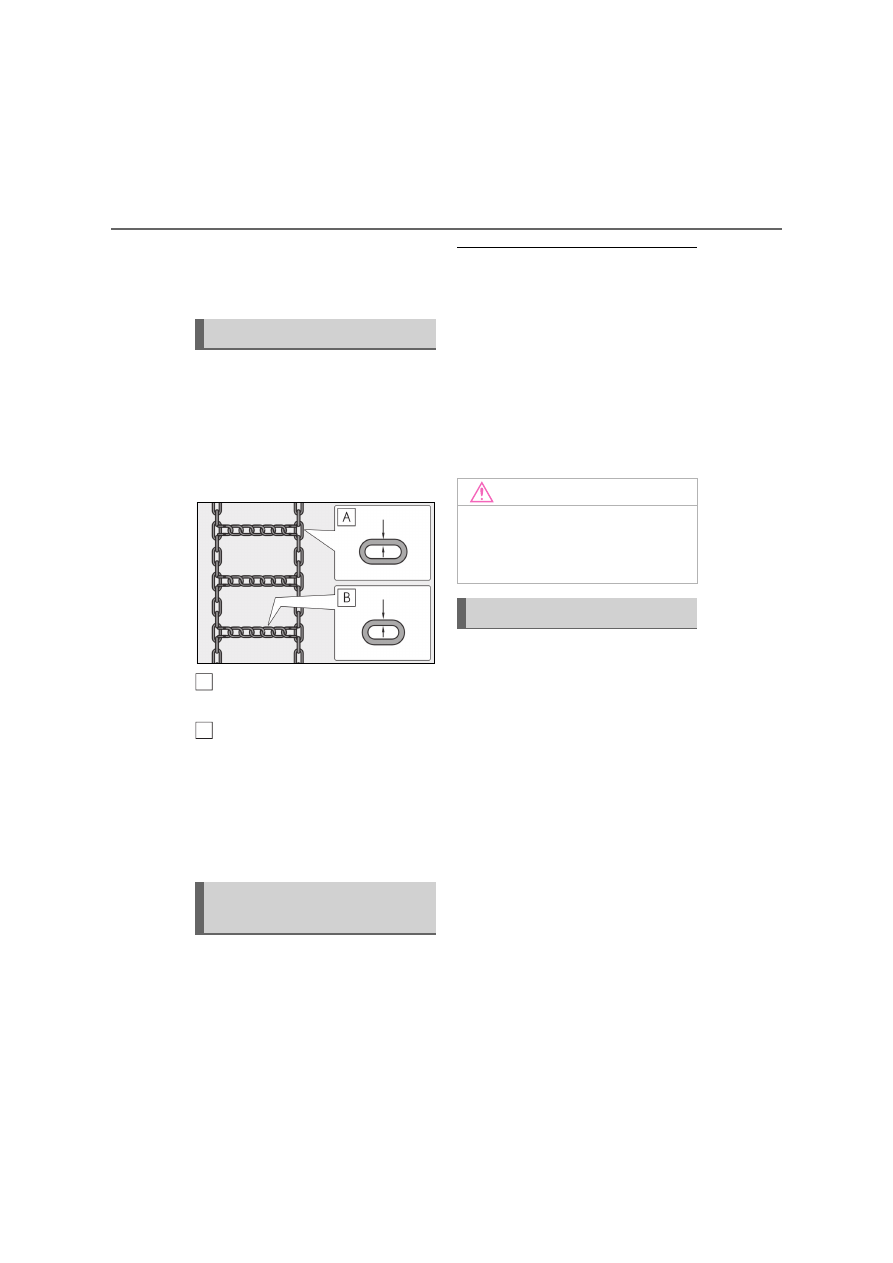
298
4-6. Driving tips
because it may cause the vehicle to
move unexpectedly, possibly leading
to an accident.
Vehicles with front and rear tires of
the same size
Use the correct tire chain size when
mounting the tire chains.
Chain size is regulated for each tire
size.
Side chain (3 mm [0.12 in.] in diam-
eter)
Cross chain (4 mm [0.16 in.] in
diameter)
Vehicles with front and rear tires of
differing sizes
Tire chains cannot be mounted.
Snow tires should be used instead.
Regulations regarding the use of tire
chains vary depending on location and
type of road. Always check local regu-
lations before installing chains.
Q
Tire chain installation
Observe the following precautions when
installing and removing chains:
O
Install and remove tire chains in a safe
location.
O
Install tire chains on the rear tires. Do not
install tire chains on the front tires.
O
Install tire chains on rear tires as tightly as
possible. Retighten chains after driving
0.5 - 1.0 km (1/4 - 1/2 mile).
O
Install tire chains following the instruc-
tions provided with the tire chains.
To enable the windshield wipers to be
lifted when heavy snow or icy condi-
tions are expected, change the rest
position of the windshield wipers from
the retracted position below the hood
to the service position using the wiper
lever. (
P.217)
Selecting tire chains
Regulations on the use of tire
chains
A
B
NOTICE
Q
Fitting tire chains
The tire pressure warning valves and
transmitters may not function correctly
when tire chains are fitted.
Windshield wipers
5
299
5
In
te
rior f
eat
ur
es
Interior features
5-1. Remote Touch
Remote Touch. . . . . . .
300
5-2. Lexus Climate Concierge
Lexus Climate Concierge. .
304
5-3. Using the air conditioning system
Automatic air conditioning system
. . . . . . . . . . . . . .
306
Heated steering wheel/seat heat-
ers/seat ventilators/neck heat-
ers. . . . . . . . . . . . ..
314
5-4. Using the interior lights
Interior lights list. . . . . . ..
318
5-5. Using the storage features
List of storage features . . ...
320
Trunk features. . . . . . . .
322
5-6. Using the other interior features
Other interior features . . ...
323
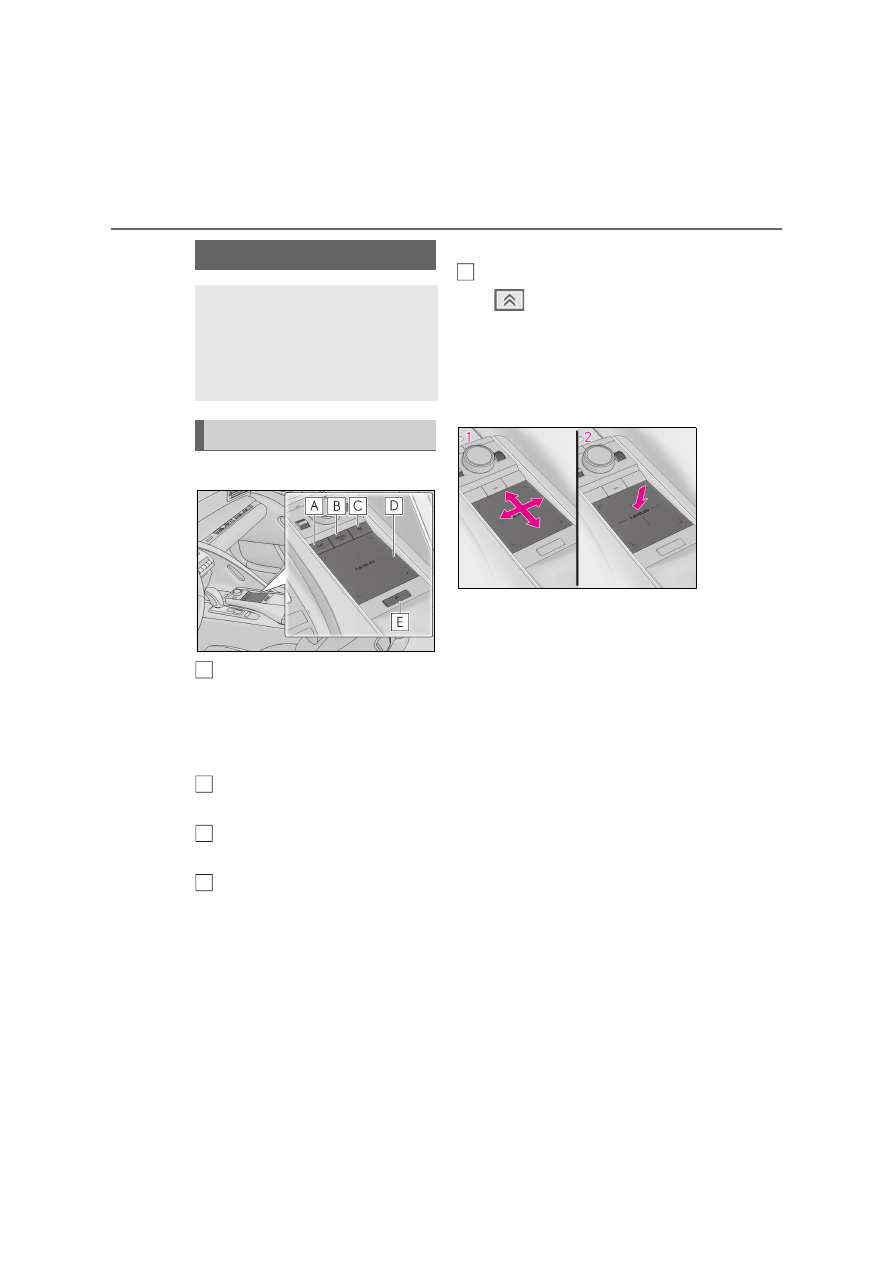
300
5-1. Remote Touch
5-1.Remote Touch
Q
Switches
“MAP” button/ “HOME” button
“MAP” button: Press to display the current
location.
*
“HOME” button: Press to display the home
screen.
*
“MENU” button
Press to display the menu screen.
Back button
Press to display the previous screen.
Touchpad
Slide your finger on the touchpad and
move the pointer to select a function, letter
and screen button.
Press the touchpad to enter the selected
function, letter or screen button. Certain
finger movements on the touchpad can
perform functions, such as changing map
scalings and scrolling list screens.
Sub function button
When
is displayed on the screen, a
function screen assigned to the screen can
be displayed.
*
: Refer to the “NAVIGATION SYSTEM
OWNER’S MANUAL”.
Q
Using the touchpad
1
Select: Touch the touchpad to
select the desired button on the
screen.
2
Enter: The buttons on the screen
can be selected by either depress-
ing or double tapping on the
touchpad. Once a button has been
selected, the screen will change.
Q
Touch operation
Operations are performed by touch-
ing the touchpad with your finger.
Trace
Trace the pad surface while maintaining
contact with the touchpad. Moving the
cursor and the pointer.
Remote Touch
The Remote Touch can be used to
operate Center Display.
For details on the Remote Touch,
refer to the “NAVIGATION SYS-
TEM OWNER’S MANUAL”.
Remote Touch operation
A
B
C
D
E

301
5
5-1. Remote Touch
In
te
rior f
eat
ur
es
Double tap
Tap the touchpad twice, quickly. Select the
button on the screen.
Flick
Quick and long movement along the
touchpad with your finger. Move the list
screen.
Pinch in/Pinch out
Slide fingers toward each other or apart on
the touchpad. Change the scale of the
map.
Q
Menu screen
Press the “MENU” button on the
Remote Touch to display the menu
screen.
The display may differ depending on
the type of the system.
NOTICE
Q
To prevent damage to the Remote
Touch
Observe the following precautions. Fail-
ure to do so may cause damage to the
Remote Touch.
O
Do not allow the Remote Touch to
come into contact with food, liquid,
stickers or lit cigarettes.
O
Do not subject the Remote Touch to
excessive pressure or strong impact.
O
Do not push the touchpad with a
strong force or use a sharp pointed
object to operate the pad.
Center Display overview
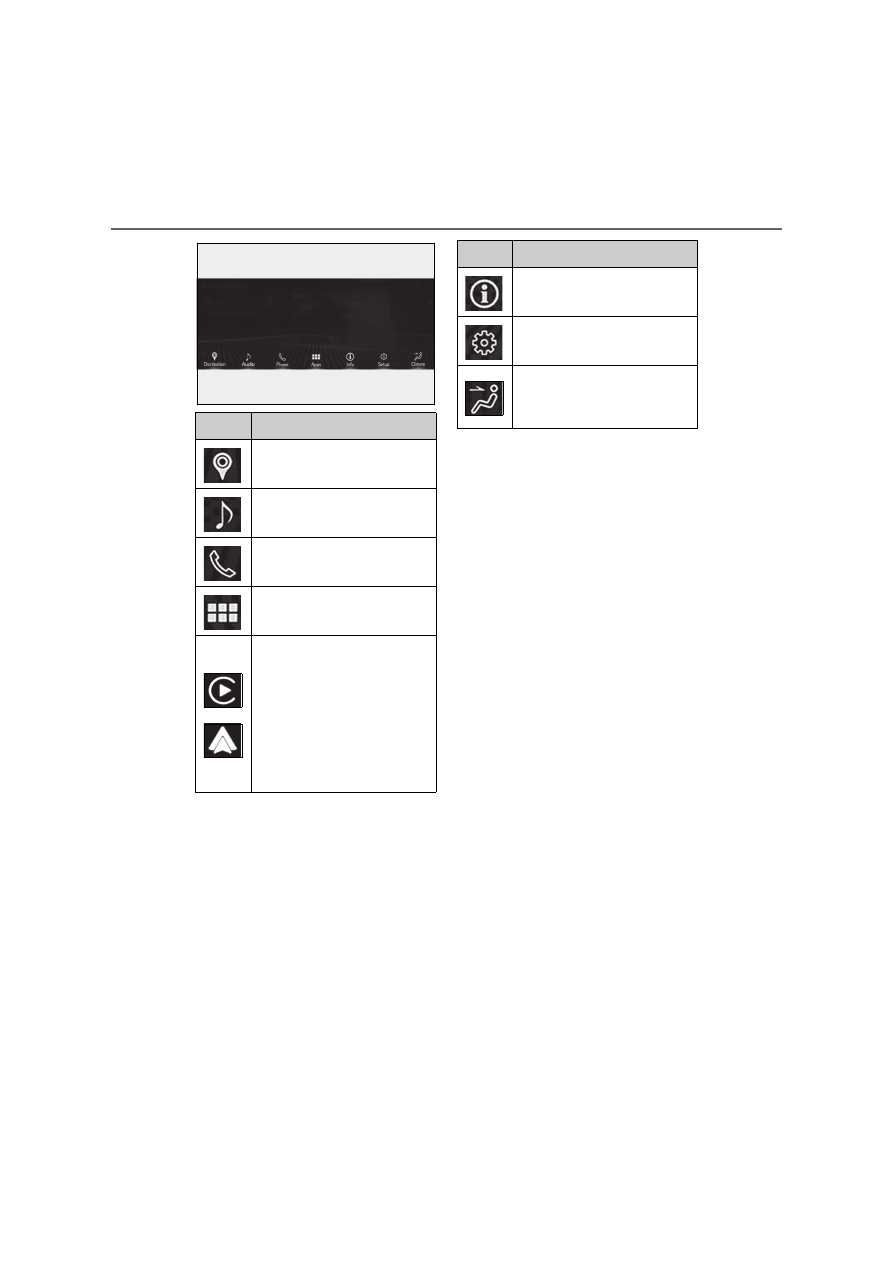
302
5-1. Remote Touch
*1
: Refer to the “NAVIGATION SYSTEM
OWNER’S MANUAL”.
*2
: If equipped
*3
: This function is not made available in
some countries or areas.
Q
Split-screen display
Different information can be displayed on the left and right of the screen. For
example, air conditioning system screen can be displayed and operated while the
fuel consumption information screen is being displayed. The large screen on the
left of the display is called the main display, and the small screen to the right is
called the side display.
Switch
Function
Select to display the destination
screen.
*1, 2
Select to operate the audio con-
trol screen.
*1
Select to display the hands-free
control screen.
*1
Select to display application
screen.
*1, 3
/
When an Apple
CarPlay/Android Auto connec-
tion is established and this but-
ton displays “Apple
CarPlay”/“Android Auto”,
select to display the home
screen of Apple
CarPlay/Android Auto.
*1, 3
Select to display the information
screen.
*1
(
P.103)
Select to display the general set-
tings screen.
*1
Select to display the air condi-
tioning control screen.
(
P.309)
Switch
Function

303
5
5-1. Remote Touch
In
te
rior f
eat
ur
es
Q
Main display
For details about the functions and
operation of the main display, refer to
the respective section and “NAVIGA-
TION SYSTEM OWNER’S MAN-
UAL”.
Q
Side display
The following functions can be dis-
played and operated on the side dis-
play.
Select
or
to display the desired
screen.
Navigation system
*
Audio
*
Vehicle information (
P.104)
Air conditioning system (
P.310)
Show/hide the side display
*
: Refer to the “NAVIGATION SYSTEM
OWNER’S MANUAL”.
Q
Screen display during low temperatures
When the ambient temperature is
extremely low, screen response may be
delayed even if the Remote Touch is oper-
ated.
A
B
C
D
E

Нет комментариевНе стесняйтесь поделиться с нами вашим ценным мнением.
Текст